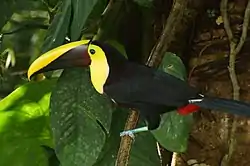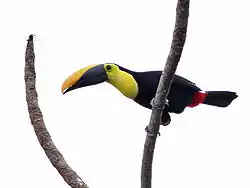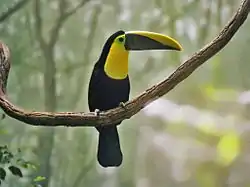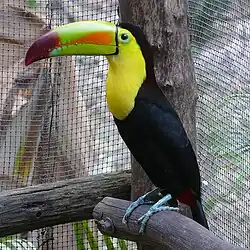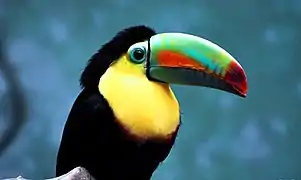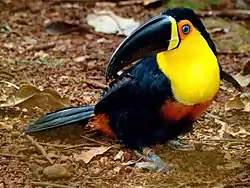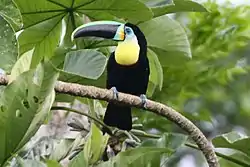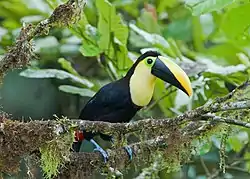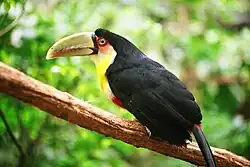List of toucans
Ramphastos is a genus of large neotropical Piciform birds within the family Ramphastidae commonly known as toucans. Toucans are members of the Ramphastidae family of neotropical birds, and only two of them, mountain toucans and typical toucans, have birds with the common name toucan. The other three genera are dichromatic toucanets, green toucanets, and araçaris. Toucans are well-loved all around the world for their friendly cheeks, wide eyes, and characteristic large and brilliantly colored bills. [1]
Below is a list of currently recognized species and subspecies.
| Image | Scientific name | Description | Distribution |
|---|---|---|---|
Toco toucan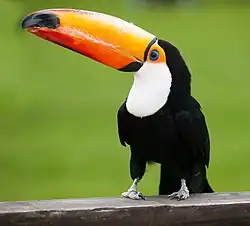 |
Ramphastos toco albogularis | Mainly black body, a white throat, chest and uppertail-coverts, and red undertail-coverts.Thin blue skin around the eye. This blue skin is surrounded by another ring of bare, orange skin. Its bill measures from 15.8 to 23 cm (6.2 to 9.1 in) in length, which is yellow-orange, tending to deeper reddish-orange on its lower sections and culmen, and with a black base and large spot on the tip. Total is 55–65 cm (22–26 in). Body weight from 500 to 876 g (1.1 to 1.93 lb).[2] | It occurs in northern and eastern Bolivia, northern Argentina, eastern and central Paraguay, eastern and southern Brazil (excluding southern Rio Grande do Sul, the dry regions dominated by Caatinga vegetation and coastal regions between Ceará and Rio de Janeiro). Other disjunct populations occur along the lower Amazon River (Ilha de Marajó west approximately to the Madeira River), far northern Brazil in Roraima, coastal regions of the Guianas and Venezuela.[2] |
Toco toucan.jpg.webp) |
Ramphastos toco toco | Nominate race. Similar to R. t. albogularis but with a yellowish orange tinge to the breast and a longer bill. | Eastern and southern Brazil to Paraguay, northern Bolivia and northern Argentina. |
|
Red-billed toucan |
Ramphastos tucanus tucanus | Nominate race.The rump is bright yellow and the crissum (the undertail coverts surrounding the cloaca) is red. The bare skin around the eye is blue. The bill has a yellow tip, upper ridge and base of the upper mandible, and the base of the lower mandible is blue. The rest of the bill is mainly reddish brown.It has a total length of 50–61 cm (20–24 in).[2] Body weight ranges from 425 to 830 g (0.94 to 1.8 lb).[3][4] | Eastern Venezuela to Guyana, northern Bolivia and Brazil.[3][4] |
|
Cuvier's toucan |
Ramphastos tucanus cuvieri | The rump is bright yellow and the crissum is red. The bare skin around the eye is blue. The bill has a yellow tip, upper ridge and base of the upper mandible, and the base of the lower mandible is blue. The rest of the bill is mainly black[4] | South-East Colombia to Venezuela, Brazil and Bolivia.[3][4] |
|
Chestnut-Mandibled toucan |
Ramphastos ambiguus swainsoni[5] | Like other toucans, the Chestnut-Mandibled is brightly marked and has a large bill. The male is 56 cm long, while the smaller female is typically 52 cm long. Weight ranges from 599 to 746 grams (1.3-1.6 lbs).. The face and upper breast are bright yellow, with narrow white and broader red lines forming a lower border. The upper tail is white and the lower abdomen is red. The legs are blue.[5] | Eastern Honduras to northern Colombia and western Ecuador.[5] |
|
Black-mandibled toucan |
Ramphastos ambiguus abbreviatus[5] | Its plumage is mainly black. Upper breast and throat are bright yellow, with a thin red border on the throat, a creamy rump and a scarlet anal area. The bill is bicolor and massive, a little shorter in the female. It is lemon-yellowish on the upper side and blackish on the rest of the maxilla and on the mandible, often brown close to the base. The skin of the face around the eyes is pale green or yellow-green.This species has a total length of 47–61 cm (19–24 in) and weighs from 584 to 746 g (1.29 to 1.64 lb). | Its distribution ranges along the eastern slope of the Andes from Peru, north through Ecuador and Colombia, to Venezuela as far as the coastal ranges.[6] |
|
Black-mandibled toucan
|
Ramphastos ambiguus ambiguus | Nominate race.Similar to R.a abbreviatus but with blue facial skin. | Eastern slope of Andes of Colombia to western Venezuela and eastern Peru. |
|
Keel-billed toucan |
Ramphastos sulfuratus sulfuratus | Nominate race.Including its bill, the keel-billed toucans ranges in length from around 17 to 22 inches (42–55 cm).[3] Their large and colorful bill averages around 5–6 in (12–15 cm), about one-third of its length. It typically weighs about 380–500 grams (13.4 oz.–1.1 lbs.), it is similar to the southern race but the bill is usually longer and the red patch on the bill more extensive.The red band present on the chest of the southern race is reduced or absent.[7] | Southeastern Mexico (Puebla, Oaxaca and Veracruz) south through the Belize and northern Guatemala to Honduras[7] |
|
Keel-billed toucan |
Ramphastos sulfuratus brevicarinatus | Similar to the nominate race but red patch on the bill is less extensive,the bill is usually shorter and the red band on the chest is wide[7] | Central America (southeastern Guatemala, Belize and Honduras south through Nicaragua,Panama and Costa Rica and into South America Colombia and Venezuela[7] |
|
Channel-billed toucan |
Ramphastos vitellinus vitellinus[8] | Nominate race.Its upperparts, belly, tail and most of the bill are black, and the uppertail and undertail coverts are red. The bare eye-patch and bill base are blue, the throat is white, most of the central breast is yellow-orange fading to white laterally and the lower breast sharply contrasts with a broad transverse red band. The iris is dark brownish.It is typically 48 cm (19 in) long with a 9–14 cm (3½-5½ in) bill. It weighs 300-430 grams (10.6-15.2 oz.)[8] | Venezuela to the Guianas and Brazil north of the Amazon. Also occurs in Trinidad and northern Bolivia.[9] |
|
Yellow-ridged toucan |
Ramphastos vitellinus culminatus[8] | It resembles the nominate, but has a yellow base of the upper mandible and culmen, orange-yellow uppertail coverts and the throat and breast are white (occasionally tinged yellow), with just a narrow red band separating the latter from the black belly.[8] | Lowlands of western Venezuela to northern Bolivia and western Brazil.[10] |
|
Ariel toucan |
Ramphastos vitellinus ariel[8] | It resembles the nominate, but the base of its bill is yellow, the skin around the pale blue eye is red and the entire throat and chest are orange.[8] | Brazil, Bolivia south of the Amazon[11] |
| Citron-throated toucan
|
Ramphastos vitellinus citreolaemus[8] | It resembles culminatus, but with a clear yellow tinge to the throat, a green tinge to the otherwise blue culmen, which is yellow at the very tip, and a blue base to both the upper and lower mandible. A yellow-orange patch is present at the very base of the bill, and a pale bluish iris.[8] | Forests of Colombia and Venezuela[12] |
|
Choco toucan |
Ramphastos brevis | The Choco toucan is a large (43–45 cm ), predominantly black bird with a 15 cm long yellow and black beak, a yellow bib, white uppertail coverts, red undertail coverts and green ocular skin. It is very similar to the larger Chestnut-mandibled Toucan, but lacks brown to the beak.[13][14] | The Choco toucan is restricted to the humid Chocó forests in western Ecuador and western Colombia. Its estimated global range is over 110,000 km².[13][14] |
|
Green-billed Toucan |
Ramphastos dicolorus | It is one of the smallest species of Ramphastos toucans, weighing 265-400 grams (9.4-14.2 oz.) and measuring 40–46 cm (16–18 in) long in total.[2] Its beak is one of the shortest of Ramphastos toucans at only about 10 cm (4 in) in length. Its breast is actually orange, with yellow at the sides. The beak is mostly pale greenish-horn, leading to its common name[15][16] |
References
- "Baby Toucan - Fun Facts with Pictures - Birds Fact". 2021-12-09. Retrieved 2022-02-05.
- "Toco Toucan overview". Avian Web.com. Retrieved 8 July 2013.
- "White throated toucan overview". Avian Web.com. Retrieved 8 July 2013.
- "Cuviers Toucan on BirdForum". BirdForum. Retrieved 8 July 2013.
- "Ramphastos ambiguus overview". AvianWeb. Retrieved 8 July 2013.
- "Black-Mandibled toucan overview". AvianWeb. Retrieved 8 July 2013.
- "Keel-billed Toucan subspecies". BeautyOfBirds. Retrieved 8 July 2013.
- "Ramphastos vitellinus overview". BeautyOfBirds. Retrieved 8 July 2013.
- "Channel-billed Toucan range". Encyclopedia Of Life.com. Retrieved 8 July 2013.
- "Yellow-ridged Toucan overview". Encyclopedia Of Life.com. Retrieved 8 July 2013.
- "Ariel Toucan distribution". Encyclopedia Of Life.com. Retrieved 8 July 2013.
- "Citron-throated Toucan overview". Encyclopedia Of Life.com. Retrieved 8 July 2013.
- "Choco Toucan on BirdForum". BirdForum. Retrieved 8 July 2013.
- "Choco Toucan on AvianWeb". beautyofbirds.com. Retrieved 8 July 2013.
- "Red-breasted Toucan on BirdForum". BirdForum.net. Retrieved 8 July 2013.
- "Green-billed Toucan overview". Avian Web.com. Retrieved 8 July 2013.


